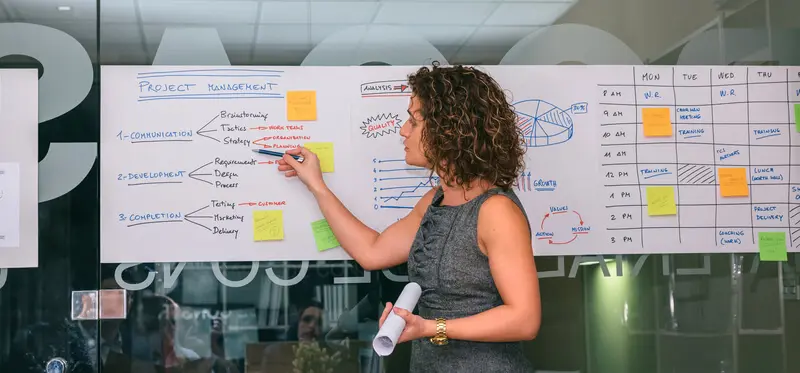Agile project management
Agile project management is now an integral part of the modern business world, revolutionizing the way projects are planned, executed and completed. In an era of rapid technological advancement and constant change, agile project management offers a dynamic approach that helps organizations adapt quickly to new requirements.
This article will dive into the world of agile project management, exploring its foundations and principles and how it helps organizations to work more flexibly, efficiently and customer-centrically. We will highlight the different agile methodologies and best practices and provide insights on how they can be successfully applied in different industries.
The significance of project management
The importance of project management lies in its ability to efficiently plan, organize and implement complex tasks and projects. In an increasingly complex business world where resources are limited and time is of the essence, effective project management is essential.
It enables companies to set clear goals, prioritize tasks, minimize risks and promote collaboration within teams. In addition, project management helps to monitor progress, ensure quality and make sure projects stay on budget and on time.
In a global economy characterized by innovation and change, project management is a key tool to gain competitive advantage and achieve successful results.
The creation and development of agile methods
The emergence and development of agile methods is closely linked to the history of software development and the need for more flexible and efficient approaches to managing project complexity. In the 1990s, the traditional waterfall method was widely used in software development, but it reached its limits, especially in projects with unclear requirements or changing customer needs.
This led to the emergence of agile methods, with the Agile Manifesto in 2001 being considered a milestone. Agile methods emphasized principles such as individual interactions, functioning software, customer collaboration and reacting to changes over extensive documentation and rigid processes. Over the years, various agile frameworks such as Scrum, Kanban, Extreme Programming (XP) and Lean principles have evolved and expanded beyond software development to other areas such as project management, product development and marketing.
This evolution has helped to shift the focus to continuous improvement and user needs, enabling organizations to respond more agilely to the ever-changing business world.
Getting started together
You have the vision, we have the expertise! At Platri IT, we transform your app ideas into digital masterpieces. Our team of highly skilled developers and creative minds are ready to bring your app dreams to life.
Whether iOS, Android or cross-platform, we deliver innovative, user-friendly solutions that will delight your target audience. Start your app project today with Platri IT as a strong partner at your side!

What is agile project management?
Agile project management is a modern approach to implementing projects that is characterized by its flexibility, customer focus and iterative approach. In contrast to traditional, linear project management, in which all steps are planned in detail from start to finish, agile project management emphasizes adaptability to changing requirements and priorities.

In agile teams, the focus is on continuous communication with customers and stakeholders to ensure that the end product meets their needs. Agile methods such as Scrum, Kanban and Extreme Programming (XP) promote short, iterative work cycles in which small parts of a project are developed in so-called sprints or iterations. This makes it possible to react more quickly to feedback, detect errors at an early stage and continuously improve quality.
Agile project management has established itself not only in software development, but also in many other industries as an extremely effective method for managing project complexity and increasing customer satisfaction.
Basics of agile project management
The basics of agile project management form the foundation for a flexible and customer-orientated project management. Approach to the implementation of projects. At its core is the Agile Manifesto, which emphasizes principles such as individual interactions over processes and tools, functioning software over comprehensive documentation, customer collaboration over contract negotiation and responding to change by following a plan.
Agile project management emphasizes iterative workflows, continuous communication with stakeholders, and the ability to respond quickly to changing requirements. Scrum, Kanban, and Extreme Programming (XP) are some of the most well-known agile methods used in practice, each offering specific practices and approaches to make projects more efficient and effective.
The basic principles are as follows:
- Iterative development: Projects are divided into short, repeated development cycles, among other things to obtain feedback more quickly, which is an essential part of the development process.
- Customer orientation: The customer is integrated into the development process and has an influence on the requirements and priorities.
- Self-organized teams: Teams are self-responsible, organize their work themselves and reflect on it continuously.
- Flexible requirements: Requirements can change during the project to meet customer needs.
- Close collaboration: Communication and collaboration between team members and stakeholders are crucial.
- Prioritization: Tasks and functions are prioritized according to their importance and customer value.
- Transparency: Project progress and status are visible and easily accessible to everyone.
- Risk management: Risks are identified at an early stage and measures are taken to minimize them.
- Sustainable speed: Teams strive for a sustainable working speed in order to maintain quality and productivity.
- Adaptive management: Management adapts to the needs of the team and the project.
In today’s business world, the fundamentals of agile project management are crucial as they give organizations the flexibility to succeed in a dynamic environment and focus on customer satisfaction.
The principles of agile project management
The principles of agile project management are fundamental guidelines that form the core of this flexible approach. These principles are based on the Agile Manifesto and serve as a guide for the implementation of agile methods in practice.
Key principles include prioritizing individual interactions and collaboration over extensive processes and tools, focusing on working outcomes over extensive documentation, working closely with customers and stakeholders through contract negotiations, and being willing to respond flexibly to change rather than strictly following a fixed plan.
These principles promote the creation of an agile culture in which teams are able to adapt quickly, utilize feedback and continuously deliver high-quality results. They are critical to the success of agile projects and help to increase customer satisfaction and efficiency in managing project complexity.
Agile vs. traditional project management
The difference between agile and traditional project management lies in the fundamental approaches and underlying philosophies. While traditional project management, often referred to as the waterfall method, relies on linear and detailed planning in which all project phases are worked through one after the other, agile project management emphasizes flexibility and adaptability.
In the agile approach, work is carried out in short, repeatable iterations in which parts of the project are developed in sprints, making it easier to implement changes and adjustments. Agile methods also emphasize close collaboration with customers and stakeholders to ensure that the final product meets their requirements. In contrast, traditional project management often focuses more on adherence to a fixed plan and extensive documentation.
| Aspect | Agile project management | Traditional project management |
|---|---|---|
| Project planning | Flexible und iterative | Detailed and comprehensive planning |
| Requirements | Requirements can change | Fixed requirements at the start |
| Communication | Close and frequent communication | Formal reporting |
| Team role | Self-organized teams | Hierarchical team structure |
| Progress tracking | Incremental milestones | Milestones and Gantt diagrams |
| Customer involvement | High customer involvement | Limited customer involvement |
| Risk management | Continuous adjustment | Early identification and planning of risk |
| Delivery speed | Fast but incremental deliveries | Subsequent major deliveries |
| Adaptation to changes | Lightweight and cost-effective | Complex and expensive |
The choice between agile and traditional approaches depends on the specific requirements of the project, the corporate culture and the objectives, with many organizations increasingly integrating agile practices into their project management processes in order to work in a more flexible and customer-oriented way.
Agile methods at a glance
Agile methods have become an integral part of the world of project management and software development. They represent a revolutionary approach that focuses on flexibility, customer orientation and continuous improvement. As already mentioned, Scrum, Kanban, extreme programming and lean principles are the most prominent agile methods.
Scrum
Scrum is one of the best-known agile methods for project management and software development. It is based on clear principles and processes that aim to help teams tackle complex tasks in short, iterative steps. In Scrum, a team works in sprints, which usually last two to four weeks, to achieve a specific project goal.
The work is divided into so-called backlog tasks, which are prioritized. During a sprint, the team selects tasks from the backlog and works on them until the sprint is completed. Scrum emphasizes close collaboration and communication within the team as well as regular review and adjustment of working methods.
This iterative approach makes it possible to react quickly to changes, integrate customer feedback and continuously improve the quality of work. Scrum provides a clear structure and roles, including the product owner, the scrum master and the development team, to ensure that work is carried out efficiently and effectively.
Kanban
Kanban, on the other hand, is an agile method that originated in production and was later extended to various other areas such as software development and project management. The name “Kanban” comes from the Japanese and means “card” or “board”, which refers to one of the central techniques. Kanban is based on the idea of visualizing work and optimizing the flow of work.
In Kanban, work is represented in the form of tasks or tickets on a Kanban board, which typically contains columns indicating the work status, e.g. “To Do”, “In Progress” and “Completed”. Each ticket represents a task, and the team moves these tickets from one column to the next as they progress through.
Kanban emphasizes limiting the number of tasks processed simultaneously (WIP limit) to keep the flow of work stable and avoid bottlenecks. It also encourages continuous improvement as teams can adapt the process to work more efficiently. Kanban is known for its simplicity and flexibility, making it a popular choice for teams looking to take a step-by-step approach to process optimization.
Extreme Programming
Extreme Programming (XP) is an agile software development method that aims to maximize the quality and efficiency of software development. XP is based on a set of values, principles and practices that are closely interlinked.
Core principles include continuous communication between developers and customers, a focus on simple and clear solutions, a willingness to respond to change, and the creation of high-quality code through practices such as pair programming and test-driven development (TDD).
Pair programming involves two developers working together on a piece of code to promote quality and knowledge sharing. TDD requires the development of tests before the actual code creation in order to ensure the functionality and robustness of the application. XP also emphasizes working in short iterations that are completed regularly in order to receive feedback quickly and adapt the requirements.
Overall, Extreme Programming is an agile approach that focuses on the continuous delivery of valuable software. At the same time, it strengthens skills and collaboration within the development team.
Lean principles in agile project management
The application of lean principles in agile project management is a strategy that aims to minimize waste and increase efficiency. Originating from lean production, this approach has been successfully transferred to agile methods. Lean principles emphasize the elimination of waste in the form of excessive bureaucracy, waiting times, unnecessary complexity and unused resources.
In agile project management, this means that teams constantly analyze their processes and workflows to eliminate unnecessary steps and optimize the value stream. It is also about focusing on the needs and wishes of the customer. This ensures that only those tasks and functions are developed that offer real added value. Lean principles also promote a culture of continuous improvement, where teams regularly use feedback to optimize the way they work.
Overall, the integration of lean principles helps to make agile projects more efficient by reducing unnecessary complexity and waste and focusing on creating valuable results.
The benefits of agile project management
The benefits of agile project management are manifold and have contributed to the increasing popularity of this method in many industries and organizations. First of all, agility offers a high degree of flexibility as it enables teams to adapt quickly to changing requirements and priorities. This leads to improved customer focus and satisfaction, as customers are involved in the development process and can provide ongoing feedback.
Agile methods also promote continuous improvement, as teams regularly review and adapt their working methods. By using short iterations or sprints, progress is quickly visible, which increases the motivation and commitment of team members. In addition, the risk of errors is minimized as testing and quality assurance are continuously integrated into the development process.
In this way, agile project management enables more efficient and effective project implementation and helps to strengthen the adaptability of organizations in a rapidly changing business world.
Challenges of agile methods
Although agile project management methods offer many advantages, they also come with some challenges. One of the biggest challenges is that not all projects and organizations are suitable for agile approaches. Complex large-scale projects or industries with strict regulatory requirements may have difficulty adapting to agile practices.
In addition, agile methods require strong team communication and collaboration, which can sometimes require cultural changes within the organization. Shifting from traditional to agile methods can also cause resistance and uncertainty among team members.
Ongoing customer involvement can also be challenging, especially when customers have unclear requirements or frequently changing expectations. Finally, agile project management requires careful planning and monitoring, as it can be risky if teams act in an uncontrolled manner. Identifying and overcoming these challenges is crucial to the successful use of agile methods in projects.

Practical implementation of agile project management
As in other areas, the right implementation is crucial for success. The practical implementation of agile project management requires a clear methodology and the consistent application of agile principles.
First of all, it begins with careful planning of the project, in which the objectives, scope and priorities are defined. This involves adding tasks to the product or project backlog, which are processed in short work cycles known as sprints or iterations.
During a sprint, the team selects tasks from the backlog and works on them, with progress being tracked in daily stand-up meetings. Close collaboration with customers and stakeholders is crucial to obtain feedback and ensure that the features developed meet their requirements.
Throughout the process, issues and bottlenecks are continuously identified and addressed to optimize the workflow. The practical implementation of agile project management also requires the use of appropriate tools. These include Kanban boards or project management software to keep track of tasks and progress.
In summary, the successful implementation of agile methods is based on a combination of a clear understanding of the process, teamwork and a willingness to continuously adapt and improve.
Success factors for agile project management
All of these points are already success factors for agile project management and are therefore crucial to fully exploiting the advantages of these methods. In addition, strong leadership and support from the top are essential. Managers must promote the agile culture and provide the necessary resources. Communication and transparency are further key factors. An open flow of information within the team and with stakeholders ensures that everyone involved is on the same page.
The right team composition, with the required skills and diversity, is also crucial. A continuous learning culture, where mistakes are seen as opportunities for improvement, promotes agility. Collaboration and team motivation are also critical to success, as motivated teams tend to work more effectively and creatively.
Finally, clear goals and regular reviews of project progress are also important. This ensures that the project stays on track and can be adapted if requirements change.

Tools and resources for agile project management
As mentioned, tools and resources for agile project management also play a decisive role in the successful implementation of agile methods. There are a variety of software solutions that have been developed specifically for agile teams. They help to organize the workflow, track tasks, facilitate communication and improve team collaboration.
Well-known examples of such tools are:
- Jira
- Trello
- Asana
- Monday.com
- ClickUp
- and many more
Online resources such as blogs, webinars, training materials and specialist literature are also available. These provide information and best practices in agile project management. Expert interviews and training from qualified trainers are also valuable resources to support teams in implementing agile methods.
Choosing the right tools and resources depends on the specific requirements of the project and the needs of the team. However, they are essential to optimize the agile process and ensure success.
Summary & outlook for the future
All in all, agile project management is a flexible approach based on clear principles and methods for carrying out projects efficiently and in a customer-oriented manner. The fundamentals of agile project management include an emphasis on customer communication, continuous improvement and flexible work cycles.
Agile methods such as Scrum, Kanban and Extreme Programming offer specific approaches to implementing these principles. While agile methods offer many benefits, they also come with challenges. These include adaptation difficulties and complex project environments.
Success factors for agile project management include strong leadership, open communication, the right team composition, a learning culture and clear goals. Tools and resources such as specialized software, online materials and training are also crucial to support the implementation of agile methods.
In terms of the future of agile project management, it is expected that this approach will continue to grow in importance. With the growing complexity of projects and the need to adapt quickly to changing requirements, agility will remain an indispensable part of the project management landscape.
New technologies and approaches could further develop and expand the way agile methods are implemented. In addition, agile project management could expand beyond software development into more and more industries and organizations.

Do you have further questions about app development costs?
You can reach us from Monday to Friday between 9:00 am and 5:30 pm. We look forward to hearing from you!
info@platri.de
Phone
0234 497 014 47
Do you have any further questions about our article, this topic or app development costs at Platri IT? Then please get in touch with us. If you are interested in a job at Platri IT, we look forward to your visit to our career portal. We look forward to hearing from you!

